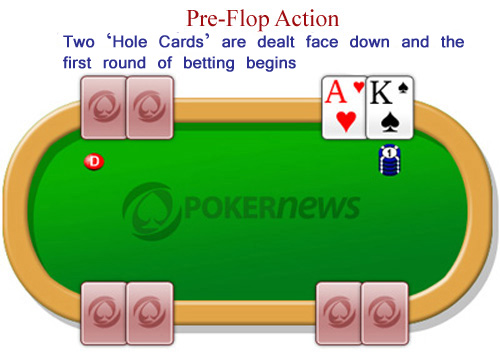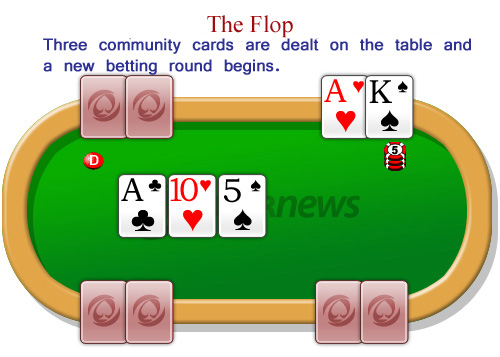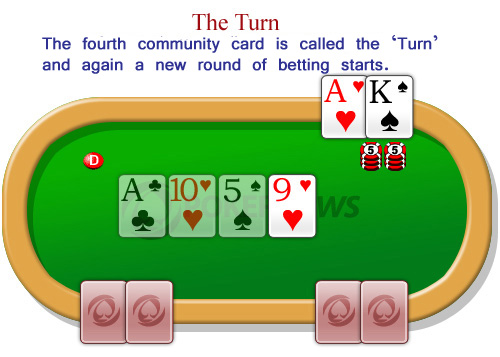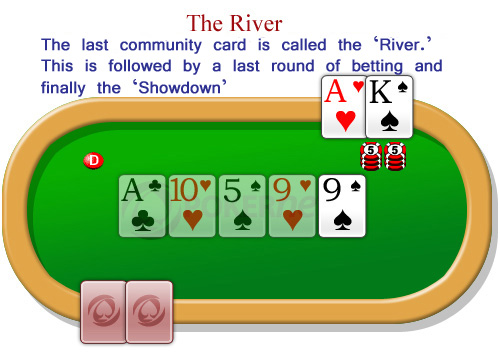Introduction
Texas Hold'em is the most popular of all poker variations. All of the marquee tournaments around the world (WSOP, WPT, EPT, etc.) are played in a variation of this game.Don't let the simplicity of the game mislead you. The number of possible game situations is so vast that, when playing at a high level, the game can be very complex. Thus the renowned expression: "It takes a moment to learn, but a lifetime to master."When playing the game for the first time, you will be confronted with some of the basic rules which are explained below. For starters, each player is dealt two hole cards in Texas hold'em with the overall goal of making the best five-card hand. Play moves clockwise around the table, starting with action to the left of the dealer button. Generally, the first two players to the immediate left of the button are required to post a small blind and a large blind to initiate the betting. From there, action occurs on multiple streets: preflop, the flop, the turn and the river.Button
The button determines which player at the table is the acting dealer. In Texas Hold'em, the player on button, or last active player closest to the button, receives last action on all post-flop streets of play.When playing in casinos or online, you won't have to worry about who the dealer is. When playing with friends, everyone usually takes a turn at dealing the cards. After each hand has been completed, the button rotates one position to the left. While staff dealers handle the duty of dealing out the cards in brick-and-mortar casinos, and the process is automated online, this isn't the case in home games. A small tip is to find the most skillful dealer in the game, offer him or her a beer or a small tip and have them deal the game while the button keeps track of which player is the "dealer."While the dealer button often dictates who the first players are to begin the wagering with the small blind and big blind, it also determines where the dealing of the cards begin. The player to the immediate left of the dealer button in the small blind, receives the first card and then the dealer pitches cards around the table in a clockwise motion from player to player until each has received two starting cards.The Blinds
Before every new round, two players at the table are obligated to post blinds, or forced bets that begin the wagering. Without these blinds, the game would be very boring because no one would be required to put any money into the pot. In tournaments, the blinds are raised at regular intervals. As the number of players keeps decreasing and the stacks of the remaining players keep getting bigger, it is a necessity that the blinds keep increasing throughout a tournament. In cash games, the blinds will always stay the same for a given limit of which the game is being played.The player directly to the left of the button posts the small blind, and the player to his or her direct left posts the big blind. The small blind is generally half the amount of the big blind, although this stipulation varies from room to room and can also be dependent of the game being played.The Aim of the Game
Winning, of course! But in order to achieve this, you need to be holding the best combination of cards.In Texas hold'em, every player receives two cards face down, called hole cards. Every player keeps these cards to concealed until the end of all of the betting rounds, which is called the showdown. Texas hold'em is a game of community cards, where five cards are displayed in the middle of the table to be used in conjunction with a player's two hole cards in order to make the best five-card holding.The five community cards are displayed in the middle of the table on the flop, the turn and the river. The flop consists of the first three community cards, the turn adds another and the river completes the board with one more. These five cards are visible for every player. Once all five cards are down, players have to make the best five-card combination from these seven cards. This can be done using both of your hole cards in combination with three community cards, one hole card in combination with four community cards or no hole cards and playing all five community cards as one's hand. The player with the best combination of cards wins the pot, which is the sum of all bets that have been placed during that hand.First Betting Round
 The first round of betting takes place right after all hole cards have been dealt to each player. The first player to act is the player to the left of the big blind, and this player then has three options:Call: match the amount of the big blind
The first round of betting takes place right after all hole cards have been dealt to each player. The first player to act is the player to the left of the big blind, and this player then has three options:Call: match the amount of the big blind
Raise: increase the bet within the specific limits of the game
Fold: throw one's hand awayIf a player chooses to fold, he or she is no longer eligible to win the current hand.The amount a player can raise to depends on the game that is being played, but most commonly must be at least twice the big blind.Limit hold'em: you can only raise by the amount of the big blind
Pot-limit hold'em: you can only raise a maximum of the pot size (the total bets that have been placed at that time)
No-limit hold'em: you can raise by any amount you want up to the maximum that your chip stack allows, and betting all of your chips is deemed "all in"The players who follow have the same three options: call, raise or fold. In the case of raising, the minimum allotted amount for a raise must be equal to the original raise amount. For example, let's say the big blind in a game is $10 and the first player to act raises to $40 in a game of no-limit hold'em. The second player to act has the option to call for $40, fold and no longer play the hand, or raise to $70 as the first raise amount of $30, the difference between the wager placed and the original big blind.Second Betting Round
 After the first preflop betting round has been completed, the second betting round takes place on the flop after the first three community cards have been dealt. In this betting round, and all that follow from now on, action starts with the first active player to the left of the button. Along with the options to bet, call, fold and raise, a player now has the option to check if no betting action has occurred prior. A check simply means to pass the action to the next player in the hand.
After the first preflop betting round has been completed, the second betting round takes place on the flop after the first three community cards have been dealt. In this betting round, and all that follow from now on, action starts with the first active player to the left of the button. Along with the options to bet, call, fold and raise, a player now has the option to check if no betting action has occurred prior. A check simply means to pass the action to the next player in the hand.Third Betting Round
 The fourth community card, called the turn, is dealt face-up following all betting action on the flop. Once this has been completed, another round of betting occurs, similar to that on the previous street of play. Again players have the option to options to bet, call, fold, raise and check.
The fourth community card, called the turn, is dealt face-up following all betting action on the flop. Once this has been completed, another round of betting occurs, similar to that on the previous street of play. Again players have the option to options to bet, call, fold, raise and check.Final Betting Round
 The fifth community card, called the river, is dealt face-up following all betting action on the turn. Once this has been completed, another round of betting occurs, similar to that on the previous street of play. Again players have the option to options to bet, call, fold, raise and check. After all betting action has been completed, the remaining players in the hand with hole cards now expose their holdings to determine a winner. This is called the showdown.
The fifth community card, called the river, is dealt face-up following all betting action on the turn. Once this has been completed, another round of betting occurs, similar to that on the previous street of play. Again players have the option to options to bet, call, fold, raise and check. After all betting action has been completed, the remaining players in the hand with hole cards now expose their holdings to determine a winner. This is called the showdown.Showdown
The remaining players open their hole cards, and with the assistance of the dealer, a winning hand is determined. The player with the best combination of five cards will win the pot.
No comments:
Post a Comment